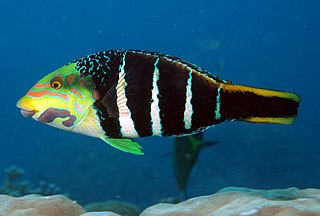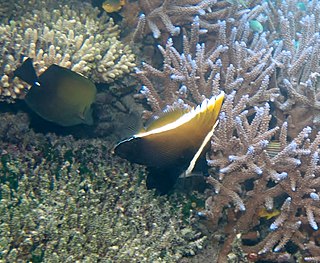
Threefin or triplefin blennies are blenniiforms, small percomorph marine fish of the family Tripterygiidae. Found in tropical and temperate waters of the Atlantic, Pacific and Indian Oceans, the family contains about 150 species in 30 genera. The family name derives from the Greek tripteros meaning "with three wings".
Rudie Hermann Kuiter is an Australian underwater photographer, taxonomist, marine biologist and author of many identification guides to sea fishes. He has described new species of seahorses in the genus Hippocampus.

The schooling bannerfish, also known as the false moorish idol, is a marine ray-finned fish, a butterflyfish from the family Chaetodontidae. It is native to the Indo-Pacific area.

Doryrhamphus and Dunckerocampus, popularly known as flagtail pipefish, are two genera of fishes in the family Syngnathidae. They are found in warm, relatively shallow waters of the Indo-Pacific, with a single species, D. paulus, in the eastern Pacific. Most of these pipefishes are very colourful, and are fairly popular in the marine aquarium hobby despite requiring special care and not being recommended for beginners.

Chelmonops truncatus, the eastern talma or truncate coralfish, is a species of marine ray-finned fish, a butterflyfish from the family Chaetodontidae. It is endemic to Australia.

Paracheilinus is a genus of flasher wrasses, native to the Indian Ocean and the western Pacific Ocean.

Apolemichthys griffisi, or Griffis angelfish, is a species of ray-finned fish, a marine angelfish belonging to the family Pomacanthidae. It is found in the Pacific Ocean. It is a rarity for the species to enter the aquarium trade.

Assessor macneilli, the blue devilfish or blue scissortail, is a fish from the southwest Pacific Ocean. It occasionally makes its way into the aquarium trade. It grows to 6 centimetres (2.4 in) in length. It is purple-blue with long fins.
Assessor flavissimus, the yellow devilfish or yellow scissortail, is a fish from the western Central Pacific, recorded from the Great Barrier Reef and Papua New Guinea. It occasionally makes its way into the aquarium trade. It grows to a size of 5.5 cm in length. It is bright yellow in colour and has a reddish-orange stripe running from the eye to the upper edge of the operculum, and a reddish-orange band on the dorsal and anal fins which is parallel to the fin margin. This species feeds on plankton and forms small groups under overhangs and ledges and in crevices, often swimming upside down. The males mouthbrood, guarding the eggs in their mouths.

Dunckerocampus is a genus of pipefishes one of two genera known as the flagtail pipefishes. This genus is native to the Indian and Pacific Oceans where they are usually found in reef environments. These species are elongated and have a maximum length between 10 and 20 centimetres, with D. chapmani being the only species with a maximum length below 15 centimetres (5.9 in). Their tail is red with a whitish edge, and in some species there is a white or yellow spot in the center. All except D. baldwini have vertical red/brown and yellow/white stripes on their body.

The barred thicklip wrasse, Hemigymnus fasciatus, is a species of fish belonging to the wrasse family, native from the Indo-Pacific.

Petroscirtes is a genus of combtooth blennies found in the western Pacific, and Indian oceans. Some species of this genus have venom that interacts with opioid receptors. Adults usually inhabit coastal reefs and estuaries to depths of about 10 meters, but they can also be found up to 15 meters in depth in sandy and weedy areas among clumps of Sargassum or other seaweeds in coastal and lagoon reefs. They can be found in nests inside small-necked bottles and abandoned worm tubes or shells.
Ecsenius ops, known commonly as the eye-spot blenny or the yellow-eye combtooth-blenny in Indonesia, is a species of combtooth blenny the family Blenniidae.

Paraplesiops is a genus containing five largely allopatric species of fishes in the longfin, or roundhead, family Plesiopidae, commonly known as blue devils, bluedevils or blue devilfish because of their colouration. The genus is most similar to the tropical genera Plesiops and Fraudella. It is restricted to subtropical and temperate rocky and coral reefs in Australian waters. Its species are mostly cryptic, occurring in submarine caves, crevices and under rocky ledges.

Heniochus monoceros, the masked bannerfish, is a marine ray-finned fish, a butterflyfish belonging to the family Chaetodontidae. It is found in the Indo-Pacific area.

Priacanthus hamrur, the lunar-tailed bigeye, goggle eye, or moontail bullseye, is a species of marine fishes belonging to the family Priacanthidae.

Taylor's garden-eel is a heteroconger belonging to the family Congridae. It is native to the central Indo-Pacific.

Hemitaurichthys zoster, commonly known as the brown-and-white butterflyfish, black pyramid butterflyfish, zoster butterflyfish, or brushtooth butterflyfish, is a marine ray-finned fish, a butterflyfish belonging to the family Chaetodontidae native to the Indian Ocean.

Heniochus varius, the horned bannerfish or humphead bannerfish, is a species of marine ray-finned fish, a butterflyfish belonging to the family Chaetodontidae, native from the central Indo-Pacific area.
Assessor randalli, Randall's assessor or Randall's devilfish, is a species of ray-finned fish belonging to the family Plesiopidae, the longfins or roundheads. It is found in the western Pacific Ocean, mainly in the seas around Japan and Taiwan. It is a similar species to Assessor macneilli but it is slightly brighter in colour and has more rounded rounder fins which have with yellow markings, there are also yellow markings on its body. They are associated with crevices and gullies in reefs, where they hover at the entrances to caves and holes. They are mouthbrooders, the male guards the eggs by keeping them in his mouth until they hatch. They are rare in the Aquarium trade but have been bred in captivity. The specific name honours the ichthyologist John Ernest Randall of the Bishop Museum in Honolulu, who collected the type specimen.
















